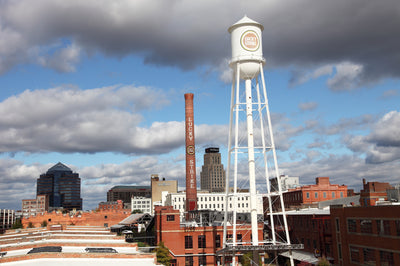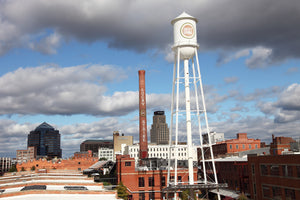Emma Schultz, M.S. | Scientific Contributor
**Updated June 18, 2021 to include current data
For our assessment of Winston-Salem’s tap water quality, we aggregated water quality test data from the Winston-Salem/Forsyth County Utility Commission, the U.S. Environmental Protection Agency (EPA), as well as from samples that we collect and analyze. Our Water Nerds cross reference these data with toxicity studies in scientific and medical literature, and look at upcoming regulatory changes. The water filters that we sell in Winston-Salem are optimized to remove the contaminants that were detected.
Source Of Winston-Salem Drinking Water
Winston-Salem’s drinking water is surface water-based, with water coming from both the Yadkin River and from Salem Lake. Water is treated at one of the three water treatment facilities operated by the City/County Utility Commission.
Lead In Winston-Salem Drinking Water
Lead enters consumer tap water through old lead service pipes and lead-containing plumbing. When corrosion control measures fail (such as recently happened in Flint, Michigan), lead leaches into drinking water and can reach toxic levels. According to the most recent Winston-Salem water quality analysis the 90th percentile concentration of 53 sampled sites of less than 3 parts per billion for lead in drinking water. While the Action Level is 15 parts per billion, the EPA, CDC and the American Academy of Pediatrics all recognize that there is no safe level of lead for children. And of course, federal regulations cannot take into account levels measured in an individual home’s tap.
Per and Polyfluoroalkyl Substances (PFAS) In Hampton Drinking Water
PFAS are a class of chemicals found in various non-stick and stain resistant products, as well as fire fighting foam. PFAS are considered to be "emerging contaminants" because they are not currently regulated by EPA, but are known to be toxic and persistent in the environment. PFAS have historically been an ingredient in fire fighting foam, which is why they're often found on or near military bases. Most municipalities don't test for PFAS, including Winston-Salem. Hydroviv undersink filters remove PFAS. If you'd like to check out third-party data on our removal rates, send us an email at hello@hydroviv.com.
Chromium 6 In Winston-Salem Drinking Water
Chromium 6 is a highly toxic metal that, while monitored, is not regulated by the EPA. Winston-Salem’s tap water quality recently averaged 52 parts per trillion for chromium 6. These average levels are 2.6 times higher than the concentration determined to have a negligible impact on cancer risk.
Disinfection Byproducts (DBPs) In Winston-Salem Drinking Water
DBPs are a category of emerging contaminants that form when chlorine-based disinfectants react with naturally-occurring organic matter. Although these chemicals are not well regulated, the EPA has stated that they are associated with an increased risk of bladder cancer, as well as kidney, liver, and central nervous system problems. EPA regulates two types of DBPs: Total Trihalomethanes (TTHMs) and Halo Acetic Acids 5 (HAA5). TTHMs in Winston-Salem’s tap water had a 2020 Local Running Annual average of 53.4 parts per billion. Consumers may be interested to know that levels of TTHMs ranged as high as 98.8 parts per billion, while the EPA’s Maximum Residual Disinfectant Level (MRDL) is only 80 parts per billion. Although these upper range values are well above the MRDL, this is not an EPA violation, since local running annual averages are used for comparison.
Use Of Chlorine In Winston-Salem Tap Water
Like most cities in the United States, Winston-Salem adds chlorine to its water supply to keep consumers safe from waterborne pathogens. While not considered harmful at low levels, many people find that removing the chlorine from their water supply results in a taste and odor improvement. When you choose to filter your tap water, we believe you will notice an immediate taste enhancement.
Still Have Questions About Winston-Salem’s Tap Water?
Hydroviv is a water filtration company that uses water quality data to optimize water filters for each city’s water. The chemicals that we list above are what we consider to be “points of emphasis” so we can build the best water filter for Winston-Salem’s tap water, but all of our water filters provide broad protection against other contaminants commonly found in drinking water (e.g. VOCs, heavy metals [including lead], pharmaceuticals, solvents, pesticides, mercury).
If you’re interested in learning more about water filters that have been optimized for Winston-Salem tap water, feel free to visit www.hydroviv.com, reach out by email (hello@hydroviv.com) or through our live chat. We also frequently post water-related news on Twitter or Facebook.
Other Articles We Think You Might Enjoy:
What Do I Need To Know About Lead Contamination And Lead Poisoning?
How To Filter Chromium 6 From Drinking Water
What Do I Need To Know About Disinfection Byproducts?
Are TDS Meters Are A Marketing Gimmick?





